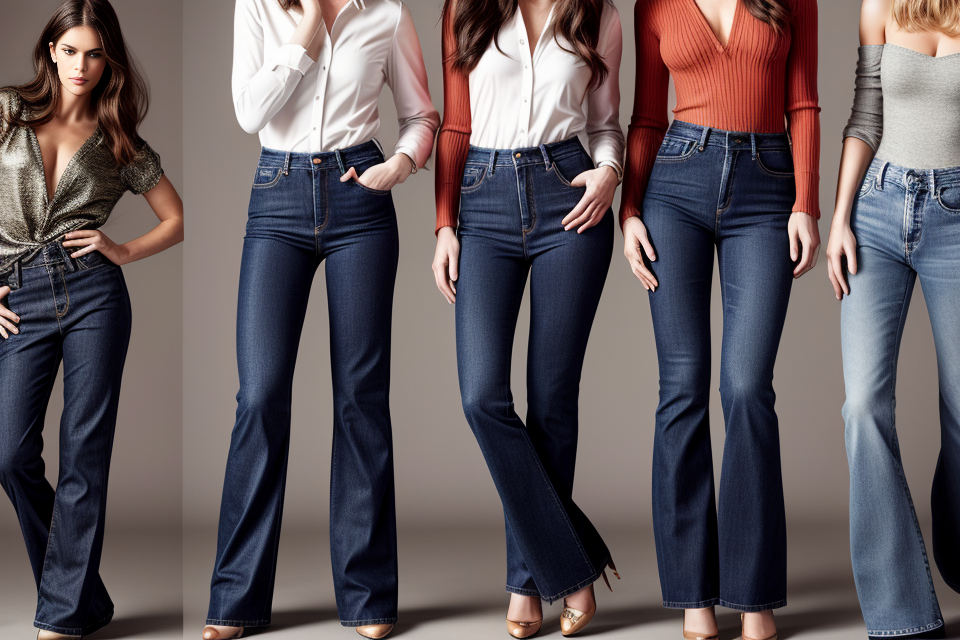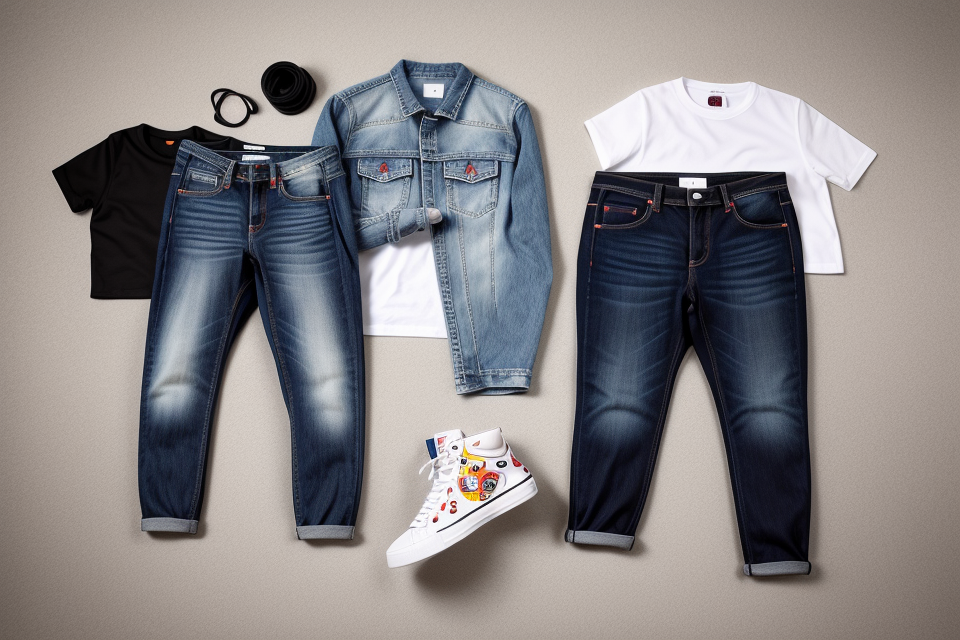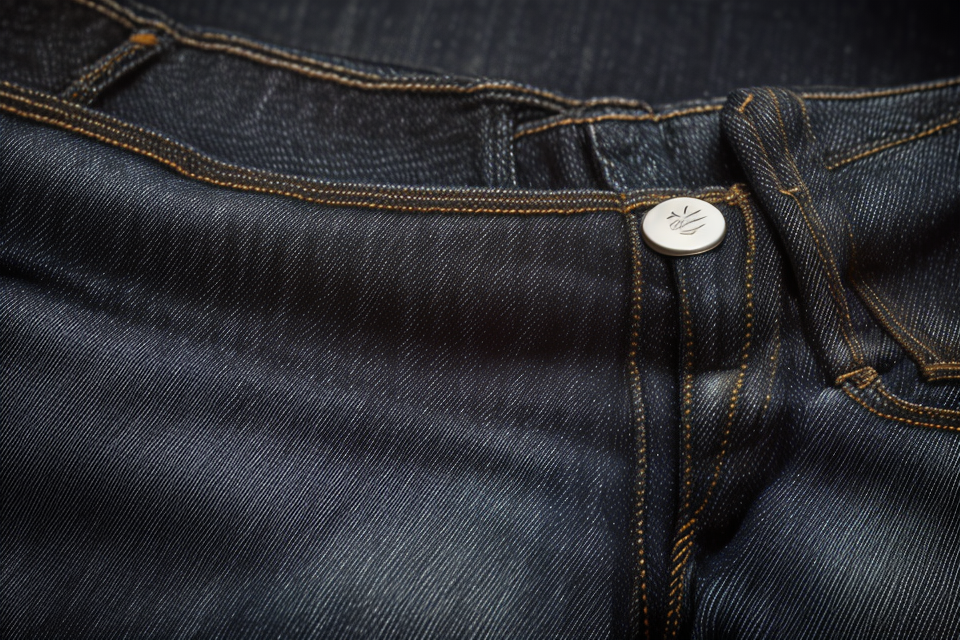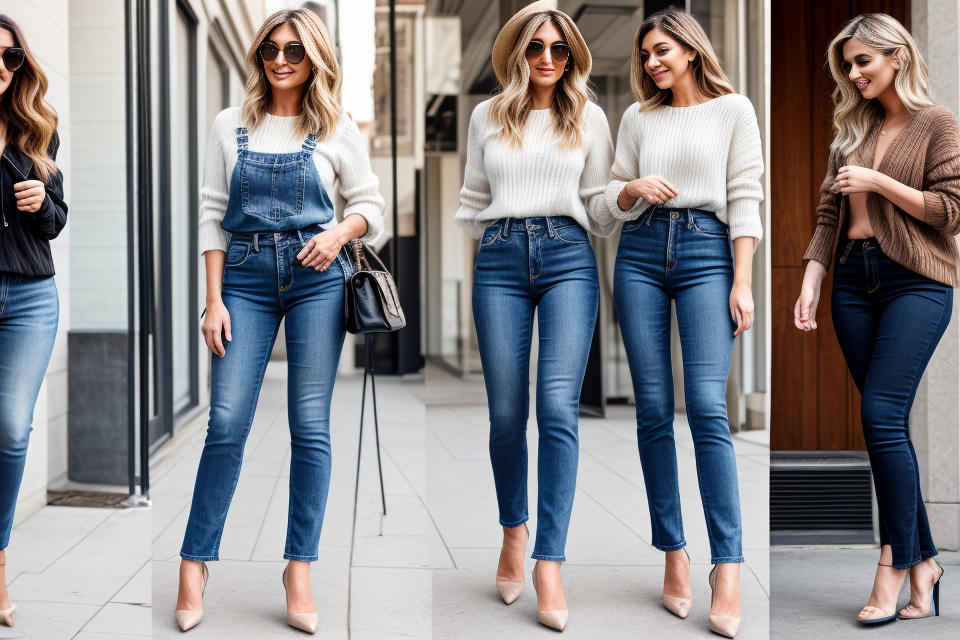Jeans are a wardrobe staple for many of us. They are versatile, comfortable, and can be dressed up or down for any occasion. But with so many styles, fits, and colors to choose from, it can be overwhelming to find the perfect pair of jeans that flatter your figure. The right pair of jeans can enhance your features, slim down your silhouette, and make you feel confident and stylish. But how do you know which jeans look best on you? This guide will provide you with a comprehensive understanding of how to choose the perfect pair of jeans based on your body type, style preferences, and occasion. So, let’s dive in and discover the secrets to finding your perfect pair of jeans!
Understanding Your Body Type
Determining Your Body Shape
When it comes to choosing the perfect pair of jeans, understanding your body shape is crucial. Your body shape refers to the way your body is proportioned, and it can have a significant impact on how different styles of jeans look on you. The four most common body shapes are hourglass, pear, rectangle, and apple.
- Hourglass: If you have an hourglass body shape, you have a defined waist and hips that are approximately the same width. Jeans that accentuate your waist and hips, such as high-waisted or belted styles, will look great on you. You should also look for jeans that are fitted through the thighs and knees, as this will create the illusion of an even more hourglass figure.
- Pear: If you have a pear-shaped body, your hips are wider than your waist, and your shoulders are narrower. You should look for jeans that balance out your hips and waist, such as straight-leg or boot-cut styles. Avoid jeans that are too tight or clingy around the hips, as this can accentuate your lower half.
- Rectangle: If you have a rectangle body shape, your shoulders, waist, and hips are approximately the same width. You should look for jeans that add some definition to your figure, such as boot-cut or flare styles. Avoid jeans that are too tight or too loose, as this can make your figure appear even more boxy.
- Apple: If you have an apple-shaped body, your shoulders and hips are approximately the same width, but your waist is less defined. You should look for jeans that create the illusion of a more defined waist, such as high-waisted styles. Avoid jeans that are too tight around the thighs, as this can accentuate your lower half.
Understanding your body shape is just the first step in choosing the perfect pair of jeans. Once you know your body shape, you can start to look for jeans that will flatter your figure and make you feel confident and stylish.
Identifying Your Waist, Hip, and Rise Measurements
- Waist:
To identify your waist measurement, you should place a tape measure around your natural waistline, which is the narrowest part of your torso, right above your belly button. Ensure that the tape measure is level and comfortable, then record the measurement. - Hips:
To find your hip measurement, position the tape measure around the widest part of your hips, ensuring that it is level and comfortable. Record the measurement. - Rise:
The rise of a pair of jeans refers to the distance from the top of the waistband to the crotch. To measure your rise, place the tape measure at the front of your waist, right above your pubic bone, and run it down to the top of the jeans’ waistband. Record the measurement.
By accurately measuring your waist, hips, and rise, you can better understand your body type and find the ideal pair of jeans that will complement your figure.
Factors Affecting Jeans Selection
Fabric Type
When it comes to choosing the perfect pair of jeans, the fabric type is an essential factor to consider. The right fabric can make all the difference in how your jeans look, feel, and fit. Here are some common fabric types for jeans and what to look for when selecting them:
Cotton
Cotton is a popular choice for jeans due to its durability, breathability, and comfort. It is a natural fiber that wicks moisture away from the body, keeping you cool in the summer and dry in the winter. Cotton jeans are also known for their softness and can be found in a variety of weights, from lightweight summer denim to heavyweight winter denim.
Pros:
- Comfortable and breathable
- Durable and long-lasting
- Wide range of styles and weights available
Cons:
- May not be as stretchy as other fabrics
- Can wrinkle easily
Denim
Denim is a classic fabric for jeans and is known for its durability and stylish appearance. It is a cotton-based fabric that is woven with a diagonal pattern, resulting in the familiar blue and white stripes on the reverse side of the fabric. Denim jeans come in a variety of weights and finishes, from lightweight summer denim to heavyweight selvedge denim.
- Classic and stylish
-
Wide range of styles and finishes available
-
Can be heavy and hot in the summer
- May require more care and maintenance
Stretch
Stretch denim is a popular choice for jeans due to its flexibility and comfort. It is made by adding a small percentage of spandex or elastane to the cotton or cotton-based fabric, which gives it a bit of stretch. This makes it easier to move and sit in, and it can also help to smooth out the silhouette.
- Comfortable and flexible
- Easy to move and sit in
-
Can help to smooth out the silhouette
-
May lose stretch over time with washing and wearing
- Can be more expensive than non-stretch denim
Non-stretch
Non-stretch denim is a traditional fabric that does not have any spandex or elastane added to it. It is typically heavier and stiffer than stretch denim, but it can also be more durable and long-lasting. Non-stretch denim jeans are often preferred by those who want a more classic look and feel.
- Classic and timeless
-
Can be more affordable than stretch denim
-
Less flexible and comfortable than stretch denim
Fit
When it comes to selecting the perfect pair of jeans, fit is a crucial factor to consider. A well-fitting pair of jeans not only looks better but also feels more comfortable and flattering. There are several types of fits to choose from, each with its own unique characteristics.
Types of Fits
- Skinny: A skinny fit jean is designed to fit snugly around the thighs and calves, creating a more streamlined silhouette. This fit is ideal for those who have a more athletic or hourglass figure, as it can create the illusion of longer, leaner legs.
- Straight: A straight fit jean is a classic, timeless style that fits straight through the thigh and calf, creating a relaxed silhouette. This fit is ideal for those who want a more relaxed, comfortable fit that still looks stylish.
- Bootcut: A bootcut fit jean is designed to fit slightly looser through the thigh and taper down towards the ankle, creating a flattering, elongated silhouette. This fit is ideal for those who want a more comfortable, versatile fit that can be dressed up or down.
- Flared: A flared fit jean is designed to fit loosely through the thigh and flare out at the knee, creating a more playful, retro silhouette. This fit is ideal for those who want a more relaxed, comfortable fit that adds a touch of personality to their outfit.
How to Determine Your Ideal Fit
The best way to determine your ideal fit is to try on different styles of jeans and pay attention to how they look and feel on your body. Consider factors such as your body shape, personal style, and lifestyle when making your decision.
If you have a more athletic or hourglass figure, a skinny fit jean may be the best choice for you. If you prefer a more relaxed, comfortable fit, a straight or bootcut fit may be a better option. And if you want to add a touch of playfulness to your outfit, a flared fit jean may be the perfect choice.
Remember, the perfect pair of jeans is out there, and with a little experimentation and patience, you can find the fit that makes you feel confident and stylish.
Style
When it comes to selecting the perfect pair of jeans, style is a crucial factor to consider. The style of the jeans can make or break the overall look, and it is important to choose a style that flatters your body shape and personal taste. Here are some popular styles of jeans to consider:
Distressed
Distressed jeans have a worn and faded appearance, often with rips and holes. This style is popular among those who want a more edgy and rugged look. Distressed jeans can be a great choice for those who want to make a statement and stand out from the crowd.
Dark Wash
Dark wash jeans are a classic choice that never go out of style. They are typically made from a heavy denim fabric and have a deep indigo color. Dark wash jeans are versatile and can be dressed up or down, making them a great option for a variety of occasions.
Light Wash
Light wash jeans have a lighter color, often with a faded or bleached appearance. They are a popular choice for the summer months and can be dressed up or down for a variety of occasions. Light wash jeans are a great option for those who want a more casual and relaxed look.
Raw Hem
Raw hem jeans have a raw, unfinished edge on the bottom of the jeans. This style is popular among those who want a more edgy and unique look. Raw hem jeans can be a great choice for those who want to make a statement and stand out from the crowd.
In conclusion, the style of the jeans you choose can greatly impact the overall look. Consider your personal taste and body shape when selecting a style, and choose a style that flatters your figure and makes you feel confident.
Jeans Shopping Tips
In-store vs. Online Shopping
When it comes to shopping for jeans, there are two main options: in-store shopping and online shopping. Each option has its own advantages and disadvantages, so it’s important to consider your preferences and needs before making a decision.
In-store Shopping
In-store shopping offers the convenience of personalized assistance and try-on options. When you shop in person, you can get immediate feedback from sales associates who can help you find the perfect pair of jeans. You can also try on multiple pairs of jeans to see which ones fit and flatter your body best. Additionally, many stores offer a wide range of sizes and styles, so you can find the perfect pair of jeans to suit your taste and budget.
However, in-store shopping can be time-consuming and may require you to travel to a physical store. It can also be difficult to find the perfect pair of jeans in your size and style, especially if you have a unique body type or prefer a specific cut or style.
Online Shopping
Online shopping offers the convenience of being able to shop from the comfort of your own home. You can browse a wide range of jeans from different brands and retailers, and you can easily compare prices and read reviews before making a purchase. Additionally, many online retailers offer free shipping and easy returns, so you can try on multiple pairs of jeans without having to leave your house.
However, online shopping can be difficult if you need help with sizing or finding the right fit. You may also have to pay for shipping and handling, and you may not be able to try on the jeans before you buy them. Additionally, some online retailers may not offer the same level of customer service as in-store shopping, so you may not be able to get immediate feedback on your purchase.
In conclusion, both in-store and online shopping have their own advantages and disadvantages. It’s important to consider your preferences and needs before making a decision, and to keep in mind that the perfect pair of jeans may take some time and effort to find.
Finding the Right Size
Measuring your body
Before you begin shopping for jeans, it’s important to take accurate measurements of your body. This will help you determine your correct size and ensure that the jeans you purchase fit you properly. To accurately measure your body, you should use a flexible tape measure. Measure around the widest part of your waist, your hips, your thighs, and your calves. You should also measure the length of your inseam, which is the distance from your waist to your ankle.
Choosing the right size based on measurements
Once you have taken your measurements, you can use them to determine the right size of jeans to purchase. Different brands and styles of jeans may fit differently, so it’s important to keep this in mind when selecting the right size. Generally, you should aim for a snug but comfortable fit. Jeans that are too loose may gape at the waist or hips, while jeans that are too tight may be uncomfortable and restrictive. It’s also important to consider the rise of the jeans. A higher rise may be more comfortable and flattering for some individuals, while a lower rise may be more stylish. Ultimately, the right size and fit of jeans will depend on your body shape and personal preferences.
Choosing the Right Style
When it comes to choosing the right style of jeans, experimentation is key. Trying on different styles and cuts can help you determine what flatters your body shape and personal taste. Here are some tips to consider when trying to find the perfect pair of jeans:
- Experiment with different styles: There are many different styles of jeans available, from skinny to bootcut, and each style can flatter different body types in different ways. Try on a variety of styles to find the one that best suits you.
- Consider your personal preferences: While certain styles may be more flattering for certain body types, it’s important to choose a style that you feel comfortable and confident in. If you prefer a more relaxed fit, then bootcut or straight-leg jeans may be a better choice for you.
- Pay attention to the rise: The rise of a pair of jeans refers to the height of the waistband. A lower rise can be more flattering for those with longer torsos, while a higher rise can be more comfortable for those with shorter torsos.
- Think about the occasion: The style of jeans you choose can also depend on the occasion. For example, if you’re looking for a more formal pair of jeans, then a dark wash straight-leg jean may be a better choice than a light wash, ripped pair.
Overall, the key to finding the perfect pair of jeans is to experiment with different styles and cuts, and to choose a style that flatters your body shape and personal taste.
Jeans Care and Maintenance
Proper Washing Techniques
Proper washing techniques are crucial in maintaining the quality and longevity of your jeans. Here are some tips to ensure that your jeans stay in good condition:
- Avoiding damaging jeans during washing: Jeans are made of durable materials, but they can still be damaged during washing if not handled properly. Avoid using harsh detergents, as they can cause damage to the fabric and weaken the fibers. It’s also best to wash your jeans inside out to prevent damage to the pockets and seams.
- Proper drying techniques: After washing your jeans, it’s important to dry them properly to prevent shrinkage and other forms of damage. Avoid using high heat settings when drying your jeans, as this can cause them to shrink and lose their shape. Instead, try air-drying your jeans or using a low heat setting in the dryer. It’s also a good idea to remove your jeans from the dryer as soon as they’re done to prevent further shrinkage.
Storing Jeans
When it comes to keeping your jeans in good condition, proper storage is key. Follow these tips to ensure that your jeans stay looking their best:
- Store your jeans in a cool, dry place: Heat and humidity can cause jeans to stretch and lose their shape, so it’s best to store them in a cool, dry place like a closet or dresser.
- Prevent creasing and wrinkles: To prevent creasing and wrinkles, try storing your jeans on a clean, flat surface, rather than hanging them up. This will help to minimize the amount of pressure on the fabric and reduce the risk of damage.
- Use a clean, dry cloth to cover your jeans: If you do need to store your jeans in a stack, use a clean, dry cloth to cover the top pair. This will help to prevent creasing and keep the jeans looking fresh.
- Rotate your jeans: To prevent wear and tear, it’s a good idea to rotate your jeans so that they get a chance to rest and recover. This will help to extend the life of your jeans and keep them looking their best.
Jeans Repair and Alterations
- Minor repairs
- Holes or tears
- Frayed edges
- Missing buttons
- Zipper malfunctions
- Hemming
- Lengthening jeans
- Taking up excess fabric
- Altering waist or length
- Adjusting the fit around the waist
- Customizing the inseam length
Minor repairs are essential for maintaining the appearance and functionality of your jeans. Holes or tears can be mended using patches or thread to prevent further deterioration. Frayed edges can be trimmed or secured with a sewing machine to maintain the jeans’ integrity. Missing buttons can be replaced or reattached to keep the jeans securely fastened. Zipper malfunctions can be fixed by reattaching the slider or replacing the damaged zipper teeth.
Hemming is a crucial aspect of jeans repair and alterations. If your jeans are too long, they can be shortened by cutting off the excess fabric and sewing the remaining hem. Similarly, if your jeans are too short, they can be lengthened by adding fabric to the bottom. Taking up excess fabric can also help slim down the silhouette and create a more tailored look.
Altering the waist or length of your jeans can provide a more personalized fit. Adjusting the fit around the waist can be done by altering the waistband or taking in the sides of the jeans. Customizing the inseam length can be achieved by adjusting the hem or adding fabric to the inside of the jeans. Properly altering the waist or length can ensure a comfortable and flattering fit that suits your body type.
Frequently Asked Questions
Can I wash my jeans in hot water?
One of the most frequently asked questions about jeans care and maintenance is whether it’s safe to wash them in hot water. The answer is yes, but with a few caveats. Hot water can help to remove tough stains and dirt, but it can also cause jeans to shrink, fade, or lose their shape. To avoid these issues, it’s recommended to wash jeans in cold or warm water, and to avoid using chlorine bleach on protein-based stains like blood or salad dressing. Additionally, it’s important to read the care label on your jeans, as some types of denim may be sensitive to water temperatures above 100°F (38°C).
How do I prevent my jeans from shrinking?
Another common question is how to prevent jeans from shrinking in the wash. There are several ways to prevent shrinkage, including:
- Pre-washing: Before washing your jeans for the first time, it’s a good idea to wash them in a small amount of water to “shrink-to-fit” them to your body.
- Cold water washing: Washing your jeans in cold water will help to prevent shrinkage, as hot water can cause denim fibers to contract.
- Air-drying: Avoid putting your jeans in the dryer, as the heat can cause them to shrink. Instead, air-dry your jeans or use a low-heat setting in the dryer.
- Ironing: If your jeans do shrink in the wash, you can try ironing them to restore their original shape. Use a low heat setting and be careful not to iron over any embellishments or decorations.
Can I wear my jeans in the rain?
Finally, some people wonder if it’s okay to wear their jeans in the rain. The answer is yes, but it’s important to take some precautions to prevent damage to your jeans. If you’re caught in a sudden downpour, try to find shelter as soon as possible to avoid getting your jeans too wet. If you’re wearing dark-colored jeans, they may appear lighter after being washed, so it’s a good idea to wash them less frequently. Additionally, avoid wearing your jeans in the rain for extended periods of time, as this can cause them to become heavy and uncomfortable.
FAQs
1. What are the different styles of jeans available?
There are various styles of jeans available, including straight-leg, boot-cut, flared, and skinny. Each style has its own unique fit and silhouette, so it’s important to choose the one that flatters your body shape the most.
2. How do I determine my body shape?
Determining your body shape is the first step in choosing the right pair of jeans. You can determine your body shape by identifying your proportions, such as your waist, hips, and thighs. Common body shapes include hourglass, pear, and apple.
3. What are the best cuts of jeans for my body shape?
The best cut of jeans for your body shape depends on your proportions. For example, if you have an hourglass figure, you may want to opt for a pair of jeans that emphasizes your waist, such as a high-waisted style. If you have a pear-shaped body, you may want to choose a pair of jeans that tapers at the ankle to create the illusion of longer legs. If you have an apple-shaped body, you may want to choose a pair of jeans that sits below your waist to create the illusion of a slimmer silhouette.
4. How do I determine my jeans size?
To determine your jeans size, you should take your measurements and compare them to the size chart of the jeans you’re interested in. Keep in mind that different brands may have different size charts, so it’s important to check the specific brand’s size chart before making a purchase.
5. Can I wear stretch jeans if I have a larger body?
Yes, stretch jeans can be a great option for people with larger bodies. Stretch jeans are designed to be comfortable and flattering, and they can be a good choice for people who want a little extra room in their jeans.
6. How should I care for my jeans?
To keep your jeans looking their best, it’s important to care for them properly. This includes washing them in cold water, as hot water can cause them to shrink and lose their shape. You should also avoid using chlorine bleach on dark colors, as it can cause them to yellow over time. It’s also a good idea to avoid wearing your jeans every day, as this can cause them to wear out more quickly.



